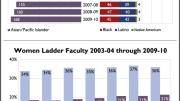The number of ladder faculty members at Harvard (professor, associate professor, assistant professor) rose by 96 (7 percent) from 2003-2004 to the current academic year: a period during which women made gains, but—among underrepresented minorities—black and Latino professors showed only slow progress. The data were published in November in the annual report of the Office of Faculty Development and Diversity (FD&D—www.faculty.harvard.edu). Ironically, in the current economic climate, further progress may come principally from retirements by full professors, who constitute two-thirds of the faculty.
Women now hold 26 percent of Harvard’s ladder-faculty positions (395 out of 1,507) and minorities 17 percent (258 positions) according to the report. Both groups are much more heavily represented in the junior ranks.
The data, published under the auspices of senior vice provost and FD&D director Judith D. Singer, show that within the Faculty of Arts and Sciences (FAS), women hold 22 percent of the senior professorships, but 37 percent of the junior appointments. Women hold 23 percent of the full professorships in social sciences, 32 percent in humanities, 12 percent in natural sciences, and 9 percent in engineering. It’s a different story lower down the ladder: 46 percent of junior-faculty members in social sciences are women, 40 percent in humanities, 28 percent in natural sciences, and 22 percent in engineering. In the professional schools, the proportion of women in the full-professor ranks ranges from a low of 14 percent in the dental school and 16 percent in the medical school (excluding the faculty in the affiliated hospitals) to highs of 36 percent in divinity and 37 percent in education (where Singer herself is Conant professor of education).
The population of minority faculty members remains small, with Asian/Pacific Islanders accounting for 168 ladder positions (and for two-thirds of the growth in the past six years), and black, Latino, and Native American professors as a whole holding just 90 positions—respectively, 3 percent, 3 percent, and 0.2 percent of the faculty overall.
The number of women faculty members has risen by 55 (or 16 percent) during the past six years. The number of black faculty members has risen by just five since 2003-2004, to 45. From 2003-2004 to the current year, the share of junior-faculty appointments held by women has risen from 34 percent to 36 percent, while the proportion of senior-faculty appointments has risen by 3 points, to 21 percent.
Today—with new hiring slowed significantly in FAS, the largest faculty (about half the University total), and retirement incentives offered to 180 tenured professors (see harvardmagazine.com, Breaking News, December 2, 2009)—the proportionally higher representation of women among junior professors would tend to increase diversity in the wake of senior-faculty retirements, all other factors held equal. Given the very small number of black, Latino, and Native American junior professors, the effect of retirements on further diversifying the faculty from among these underrepresented groups would be negligible.









